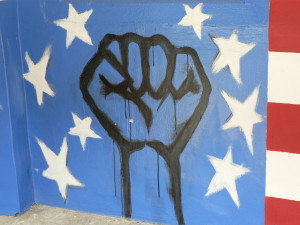There is a safeguard under our First Amendment for political protests. However, that safeguard does not extend to protests that lead to assault and battery (or worse) of other protesters, passersby, police officers, or news reporters.
Most recently, during a political rally in Chicago, for one of the Republican candidates, Donald Trump, a protest erupted. Thousands of protesters and the candidate’s supporters faced off in what started as a mere disagreement in campaign policies and slogans and ended in a “free for all.” In the aftermath of the protests, four people were arrested. One of the protesters faces one count of felony aggravated battery against a police officer and five misdemeanor counts of resisting arrest. If his main purpose for attending the rally was to go to jail, then he succeeded.
At the same time that the Chicago protests were going on, there was a similar protest in St. Louis where 32 people were arrested on similar charges of disturbing the peace and one for third degree assault. See ABC7News.
At times, it is difficult to tell the difference between a “protest” and a “riot.” The lines are blurred, and they are beginning to appear synonymous as “protesters” seem to be misconstruing their “right to assembly” with a right to take the law into their own hands. There is no grey area here. The right to “peacefully” assemble means just that. There is to be no violence of any kind.
Flashback to Another Chicago Political Protest in 1968
A war was raging in a faraway place called Vietnam, and there was a Cold War going on between the United States and the Soviet Union that started shortly after World War II. During the 1968 Democratic National Convention in Chicago, tens of thousands of anti-war protesters took to the streets and battled police officers over America’s ongoing involvement in the war.
The then Chicago Mayor, Richard Daley sent out over 12,000 police officers and 15,000 federal and state officers to restrain the protesters, and to prevent a general riot. What happened next was just the opposite of what was intended. Instead of quelling the protesters, the situation quickly escalated and eventually spiraled out of control. Due to media coverage at the time, the events of the riots were televised and brought directly into the living rooms of millions of Americans.
The bloody Chicago riot is now known as the “Battle of Michigan Avenue.” This riot created such a stir in the collective consciousness of the American people; their feelings about the government’s Cold War policies, and in particular the Vietnam War. The sentiments in this country at that time had far reaching effects. The Vietnam War went on for another seven years, with continued recrimination, and when it ended; it also ended a very sad chapter in America’s history. See the History Channel.
The First Amendment Right to Assemble
Under the First Amendment to the Constitution, Americans are guaranteed the “right to peaceably assemble.” Protesters creating chaos under the guise of exercising their First Amendment Right must understand that the word “peaceably” is the key to this “Right.” Protests that are a precursor to riots in the streets are not protected under the First Amendment.
If you have any questions concerning your rights on any issues, the Law Offices of David Freidberg are here for you.
Criminal Defense Attorney David Freidberg
If accused of a crime, it is important that you know what your rights are, and how to protect them. The need for an experienced criminal defense attorney begins with the charge and arrest. Knowing your rights is the first step in the process, and continues thereafter through a possible trial to acquittal or sentencing. So if you are being charged with any crime, including murder, sexual assault or battery, and would like to discuss all of the potential defenses available to you, call the Law Offices of David Freidberg today, at (312) 560-7100, or send an email, for a no-obligation consultation.
 Chicago Criminal Lawyer Blog
Chicago Criminal Lawyer Blog



